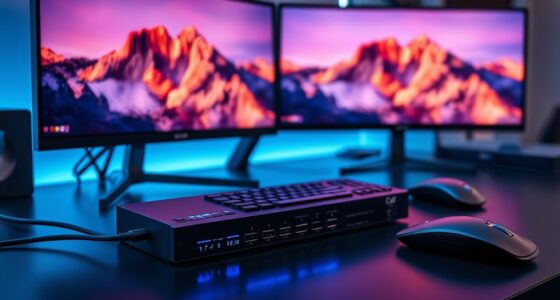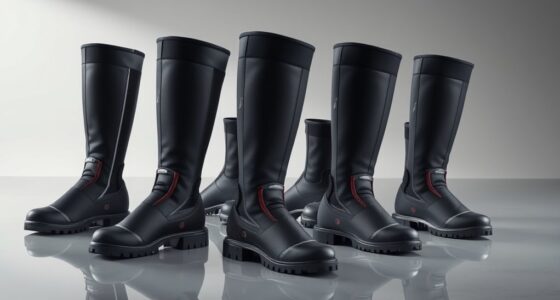If you’re starting to record and want an easy, affordable USB audio interface, I suggest checking out options like the M-Audio M-Track Solo, Focusrite Scarlett Solo, and HOSONGIN 2i2. These models are compact, user-friendly, support high-quality sound, and work well with computers and mobile devices. They’re perfect for beginners and fit various budgets. Keep exploring to find out more about each one and what makes them great choices for your setup.
Key Takeaways
- Look for models with plug-and-play setup, compatible with Mac, Windows, iOS, and Android for easy use.
- Prioritize interfaces offering 24-bit/96kHz or higher resolution for clear, professional-quality recordings.
- Choose devices with essential features like combo inputs, phantom power, and direct monitoring for versatile recording.
- Consider budget-friendly options under $150 that deliver good sound quality and user-friendly controls.
- Opt for well-reviewed models from reputable brands like Focusrite, M-Audio, and PreSonus for reliability and support.
M-Audio M-Track Solo USB Audio Interface
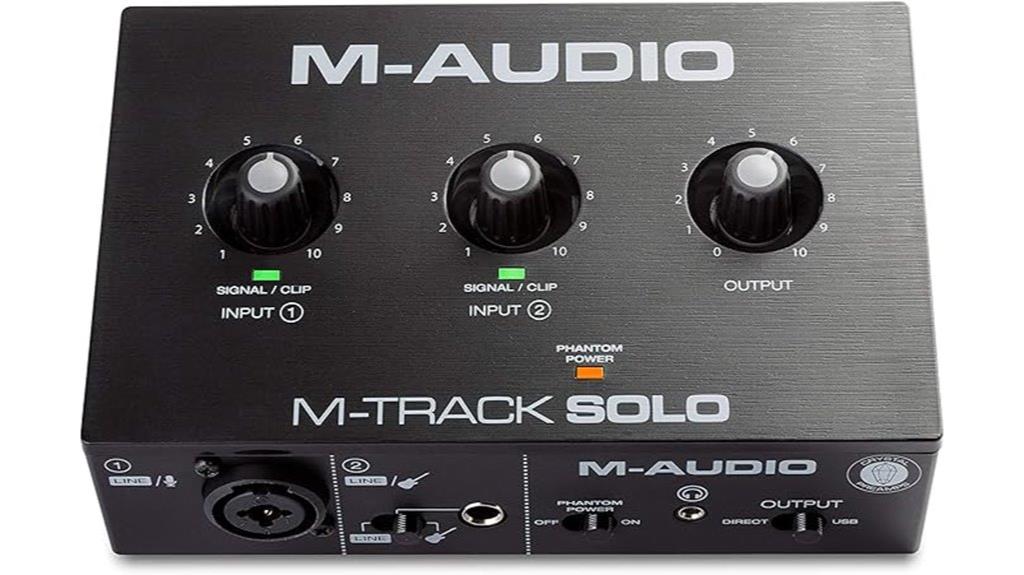
If you’re just starting out with recording, streaming, or podcasting, the M-Audio M-Track Solo USB Audio Interface is an excellent choice because it’s compact, easy to use, and offers professional-quality sound. It delivers crystal-clear 48 kHz audio and features a versatile combo input that supports microphones, guitars, and line-level devices. Powered via USB, it’s perfect for mobile setups without needing extra power sources. Zero-latency direct monitoring makes tracking smooth, and compatibility with Mac, Windows, iOS, and Android ensures flexibility. Overall, it provides reliable, high-fidelity audio in a small, portable package, ideal for beginners wanting quality sound.
Best For: beginners, hobbyists, and mobile content creators seeking an affordable, portable, and easy-to-use audio interface with professional sound quality.
Pros:
- Compact and lightweight design, ideal for portable use and small setups
- Simple plug-and-play operation with broad compatibility across Mac, Windows, iOS, and Android
- Delivers high-quality 48 kHz audio with low latency and transparent preamp performance
Cons:
- Gain knobs can be sensitive at high levels, requiring careful adjustment
- Constructed mainly from plastic, which may feel less durable over time
- Slight sound alterations during direct monitoring when compared to direct headphone use
Focusrite Scarlett Solo 3rd Gen USB Audio Interface
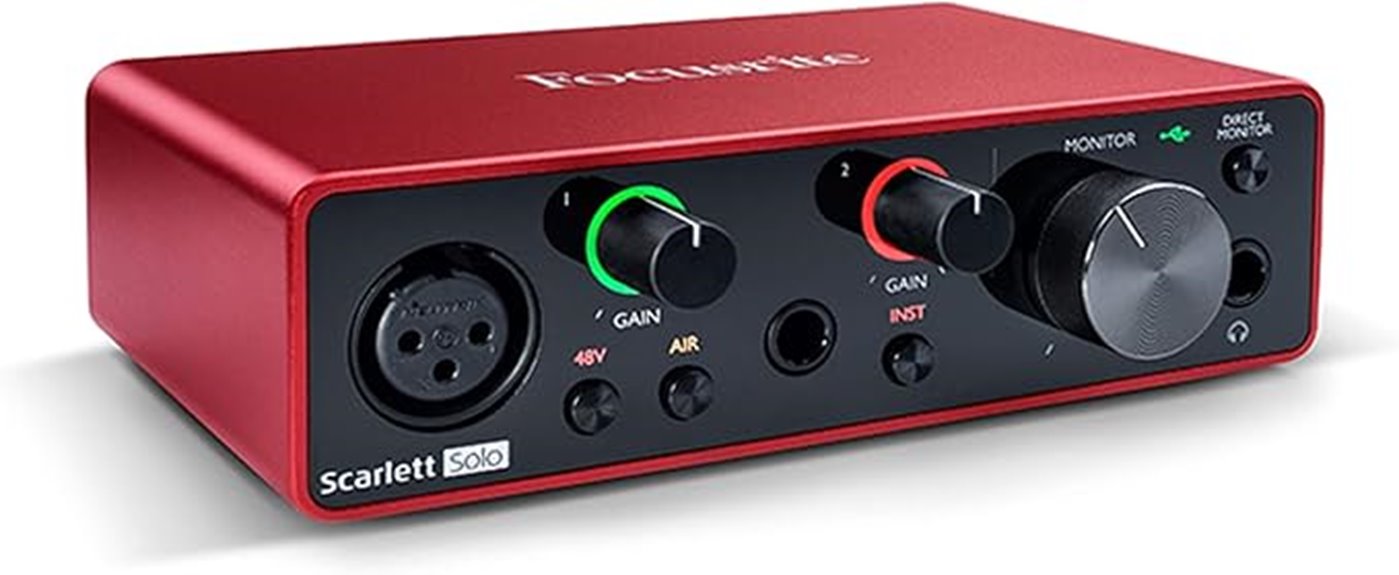
The Focusrite Scarlett Solo 3rd Gen USB Audio Interface is an excellent choice for beginners who want professional-quality sound without complicated setup. It features high-performance 24-bit/192kHz AD-DA converters for clear recordings and an upgraded third-generation mic preamp with switchable Air mode, adding brightness to vocals. The interface offers high-impedance instrument inputs, gain Halo metering, and balanced outputs for noise-free playback. Its compact, durable design connects easily via USB-C, with no external power needed. Users praise its excellent sound quality, low latency, and simple controls, making it ideal for home studios, streaming, and mobile recording.
Best For: beginners and home studio users seeking professional-quality sound with easy setup and portable design.
Pros:
- Excellent 24-bit/192kHz audio quality with clear, detailed recordings
- Compact, durable build with simple USB-C connection, ideal for mobile use
- User-friendly controls and virtual routing for streaming and live monitoring
Cons:
- Occasional driver or software issues that may require updates or configuration tweaks
- Limited inputs (one XLR and one instrument) may restrict multi-mic or multi-instrument setups
- No external power option; reliant on USB power, which might limit certain high-impedance devices
USB Audio Interface for PC and Studio Recording
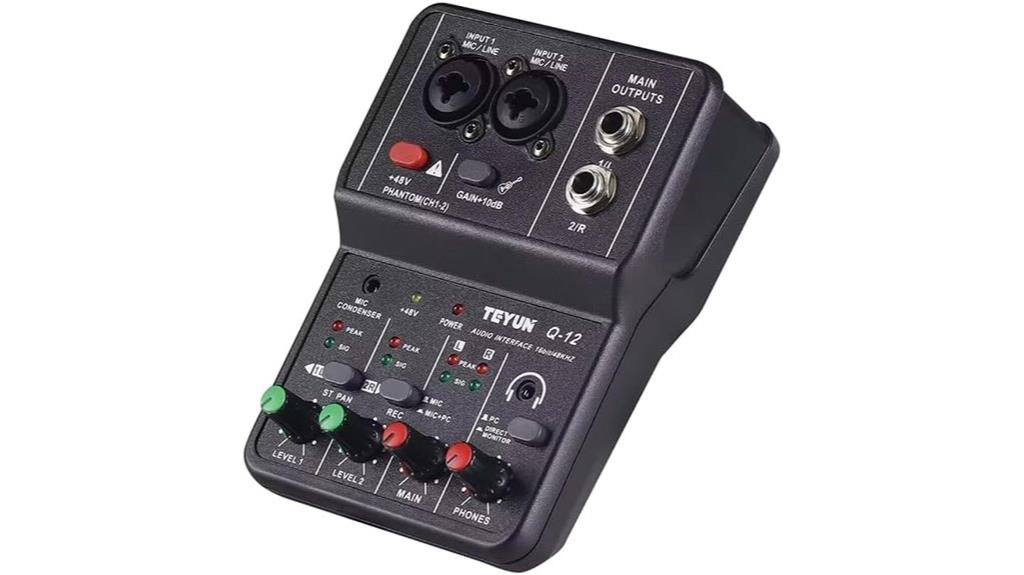
A USB audio interface designed for PC and studio recording offers ultra-low latency and plug-and-play setup, making it an excellent choice for beginners who want seamless integration with their computers. It supports recording vocals, guitar, or bass directly into recording software, with independent volume controls for precise adjustments. The high-performance converter delivers 16-bit/48 kHz studio-quality sound, ensuring clarity in recordings and playback. With features like phantom power for condenser mics, multiple input options, and a compact, portable design, this interface makes professional-quality music production accessible and straightforward for newcomers. Reliable USB connectivity guarantees stable data transfer and consistent performance.
Best For: Beginners and home studio enthusiasts seeking easy-to-use, studio-quality audio recording with minimal setup.
Pros:
- Ultra-low latency and plug-and-play design for seamless operation.
- Supports 16-bit/48 kHz studio-quality sound for clear recordings and playback.
- Compact and portable, ideal for on-the-go recording and easy setup.
Cons:
- Limited to stereo output; may not support multi-channel recording.
- Only one microphone input with phantom power, which might restrict multiple microphone use.
- Basic control interface may lack advanced features needed by professional users.
HOSONGIN 2i2 USB Audio Interface for Beginners

For beginners seeking professional-quality sound without the hassle of complex setup, the HOSONGIN 2i2 USB Audio Interface is an excellent choice. It delivers studio-grade 24-bit/192kHz recordings, perfect for podcasts, music, and content creation. The plug-and-play design means you can connect via USB and start recording in under a minute—no drivers or software needed. With an XLR input for microphones, instrument input for guitars, and zero-latency headphone monitoring, it’s versatile for various recording needs. Its durable metal build, compatibility with multiple OS and DAWs, and portable size make it a reliable, future-proof option for beginners.
Best For: beginners and content creators seeking professional-quality audio with easy, plug-and-play setup across multiple devices and operating systems.
Pros:
- Delivers studio-quality 24-bit/192kHz recordings for clear, professional sound
- Simple USB plug-and-play design requires no drivers or software to start recording quickly
- Durable metal chassis and versatile inputs (XLR and instrument) support future upgrades and various recording needs
Cons:
- Slightly higher price point compared to entry-level interfaces may be a consideration for budget-conscious users
- Limited to basic features without advanced controls or multiple input channels for professional studio setups
- Some users report that the compact size may limit onboard controls or customization options
BOMGE 2-Channel USB Audio Interface for Recording and Streaming
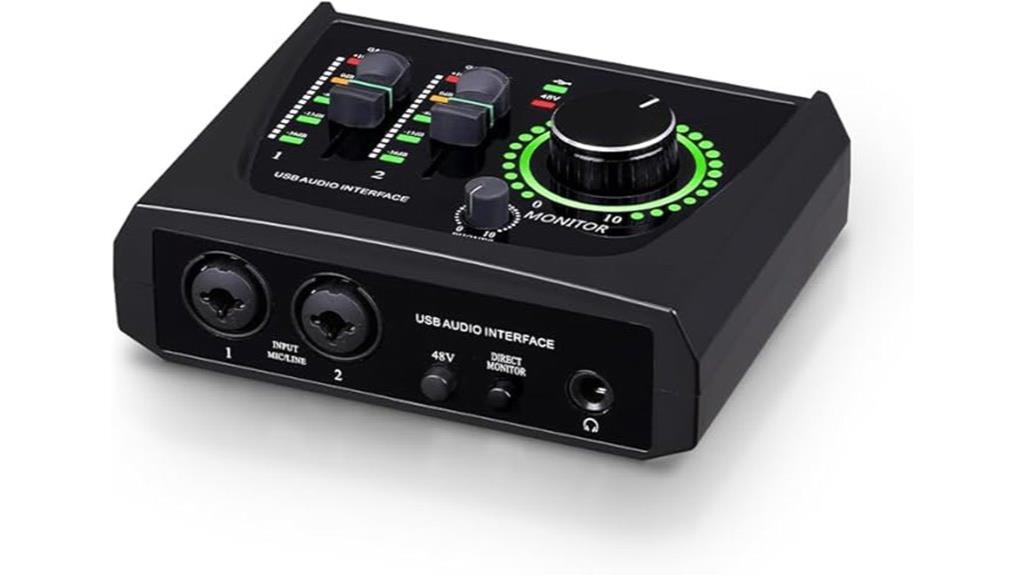
If you’re just starting out with recording or streaming, the BOMGE 2-Channel USB Audio Interface offers a straightforward, plug-and-play solution that requires no driver installation. It supports Mac OS and Windows, working seamlessly with popular software like Reaper, Ableton Live, FL Studio, and Cubase. Delivering 48 kHz high-resolution audio, it features two combo inputs with phantom power, making it easy to connect microphones, guitars, or line-in devices. The device includes balanced and unbalanced outputs for monitors and speakers, plus a headphone jack for real-time monitoring. Its compact design makes it perfect for beginners and mobile setups.
Best For: Beginners and mobile musicians seeking a simple, high-quality USB audio interface for recording, streaming, and podcasting without the need for driver installation.
Pros:
- Plug-and-play operation with no driver needed, compatible with Mac and Windows.
- Supports 48 kHz high-resolution audio for clear recordings.
- Includes 2 combo inputs with phantom power, ideal for microphones, guitars, and line-in devices.
Cons:
- Limited to 2 channels, which may not suffice for more complex recording setups.
- Lacks advanced features like onboard effects or multiple input/output options.
- May require additional accessories for full studio integration or larger setups.
PreSonus AudioBox 96 USB Audio Interface with Studio One Software
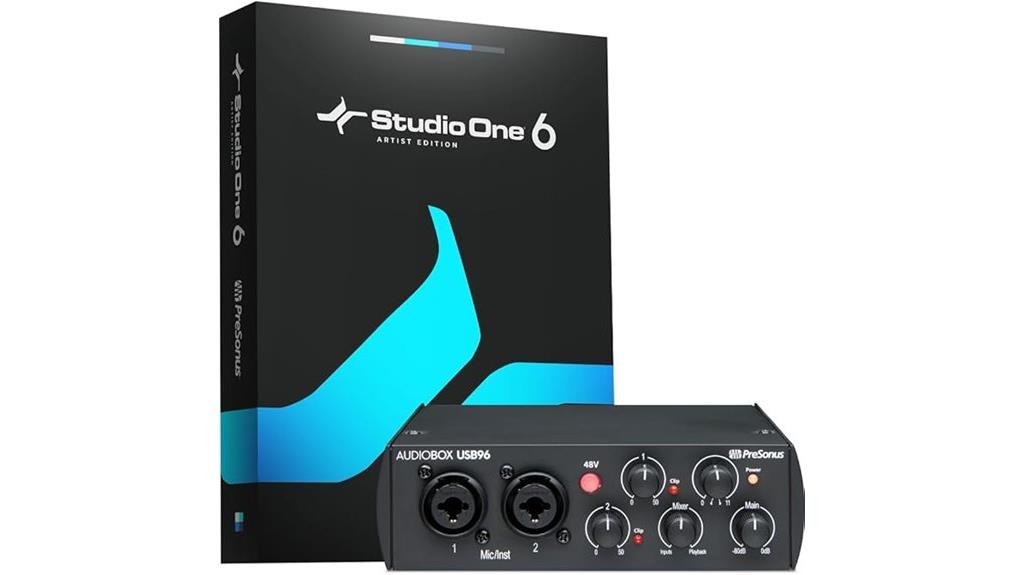
The PreSonus AudioBox 96 USB Audio Interface stands out as an excellent choice for beginners who want professional-quality sound without complicated setup. It connects via USB 2.0, is bus-powered, and is highly portable, making it perfect for recording on the go. With two high-quality Class-A mic preamps and two instrument inputs, it handles vocals, guitars, and line-level devices easily. Supporting 24-bit/96 kHz recording and playback, it delivers studio-grade sound. Plus, it comes with Studio One Artist and other software valued at over $1,000, along with flexible monitoring options, ensuring a seamless and professional recording experience.
Best For: beginners and mobile musicians seeking professional-quality recording with an easy-to-use, portable audio interface.
Pros:
- Portable and bus-powered, ideal for recording on the go
- High-quality Class-A mic preamps and 24-bit/96 kHz audio for professional sound
- Includes comprehensive software bundle valued over $1,000, such as Studio One Artist
Cons:
- Limited to two microphone inputs, which may restrict larger recording setups
- No standalone phantom power switch visible, requiring software control for condenser mics
- Might lack advanced features found on more complex interfaces for seasoned professionals
MAONO USB Audio Interface for PC with XLR Input

With high-resolution support at 24-bit/192kHz and a dynamic range of 106dB, the MAONO USB Audio Interface delivers professional-grade sound quality that’s perfect for beginners looking to produce clear, realistic recordings. It features XLR and instrument inputs with dedicated gain controls, phantom power, and impedance adjustment, making it versatile for vocals and guitar recordings. The built-in high-quality preamps support condenser and dynamic mics, while supporting up to 96kHz sampling rate ensures modern, crisp audio. Its user-friendly design, compatibility with multiple operating systems and DAWs, and compact build make it an excellent choice for those starting their audio production journey.
Best For: beginners, content creators, and home studio enthusiasts seeking an affordable, versatile audio interface with professional sound quality.
Pros:
- High-resolution recording at 24-bit/192kHz with a wide dynamic range for clear, realistic sound.
- Compatible with multiple operating systems and DAWs, offering plug-and-play setup and flexibility.
- Equipped with XLR and instrument inputs, phantom power, and dedicated gain controls for versatile recording options.
Cons:
- Occasional issues with crackling, popping, or latency, often driver-related or due to USB connection problems.
- Some users report limited preamp quality and desire additional power options or features like ADAT ports.
- Initial quality control inconsistencies and unresponsive support have been noted by a few users.
BOMGE M12 USB Audio Interface, 2-Channel Mixer, Sound Card for PC Recording
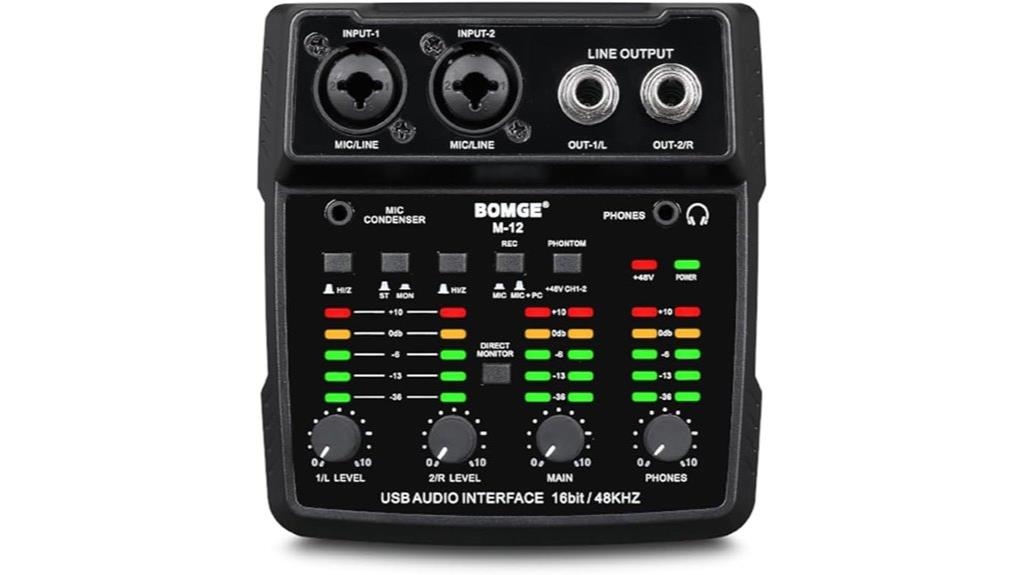
The BOMGE M12 USB Audio Interface stands out as an ideal choice for beginners who want a straightforward, affordable solution to start recording and mixing. It’s a 2-channel mixer with versatile inputs, including XLR and 3.5mm, plus phantom power for condenser mics. Its plug-and-play design makes setup simple, and independent volume controls help manage sound easily. While its sound quality is decent for beginners, some users report low output volume, background noise, and distortion at higher gains. Overall, it’s a compact, user-friendly device perfect for casual recording, practice, and learning, though serious users might want to contemplate more advanced options down the line.
Best For: beginners and hobbyists seeking an affordable, easy-to-use audio interface for casual recording, practice, and learning.
Pros:
- Affordable and portable, ideal for entry-level users
- Supports XLR and 3.5mm inputs with phantom power for condenser mics
- Simple plug-and-play setup with independent volume controls
Cons:
- Low output volume and background noise issues reported by some users
- Limited sound quality, with distortion at higher gain levels
- Inconsistent LED indicators and stiff potentiometers can affect usability
2×2 USB Audio Interface with Phantom Power and High-Fidelity Sound
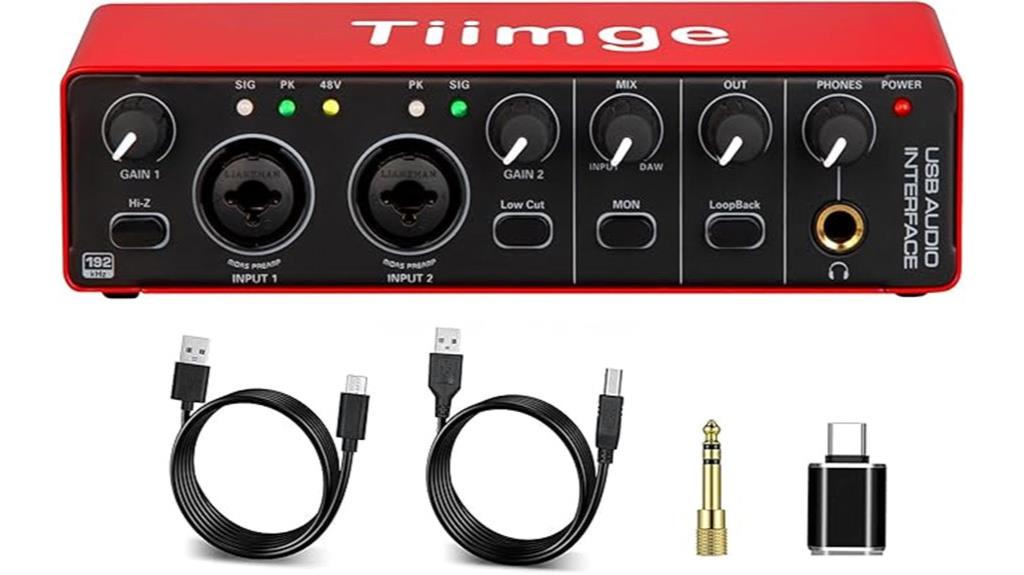
If you’re starting out and need high-quality sound recording, a 2×2 USB audio interface with phantom power and high-fidelity sound is an excellent choice. It offers 24Bit/192kHz resolution, capturing detailed audio for vocals, guitars, and instruments. The device includes 48V phantom power to energize condenser mics and is compatible with both Windows and Mac OS without needing drivers. Its two combo inputs support microphones and instruments, while the main outputs connect to monitors or speakers. Designed for ease, it’s plug-and-play, making setup quick. Versatile and compact, this interface suits beginners and professionals alike, ensuring professional-grade recordings with minimal hassle.
Best For: musicians, vocalists, podcasters, and home studio beginners seeking high-quality, easy-to-use recording equipment.
Pros:
- Provides professional-grade 24Bit/192kHz high-resolution audio for detailed sound capture
- Plug-and-play design ensures quick and simple setup without driver installation
- Supports a wide range of recording scenarios with versatile input/output options including phantom power
Cons:
- Limited to 2×2 input/output configuration, which may not suit larger setups
- May require additional accessories or cables for certain connections or studio configurations
- No built-in effects or processing, requiring external software for advanced editing
Depusheng RED USB Audio Interface for Recording Music
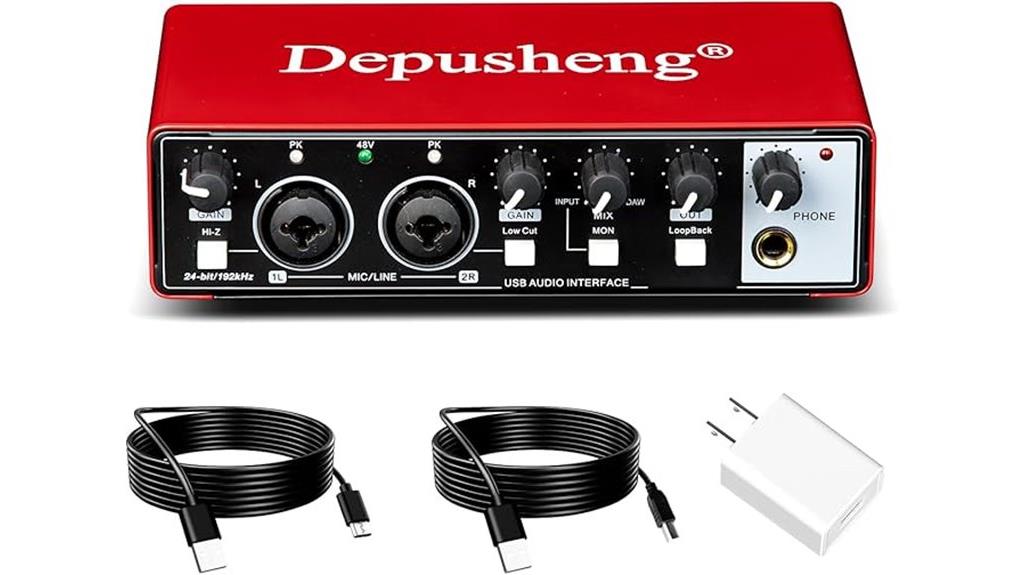
For beginners stepping into music recording, the Depusheng RED USB Audio Interface offers an excellent balance of professional-quality sound and user-friendly features. It delivers 24-bit/192 kHz clarity, supporting all essential connections for microphones, guitars, and bass. With +48V phantom power, condenser microphones are easy to use. Its compact design makes it perfect for recording at home, on stage, or in rehearsals. The interface provides dual combo inputs with high gain, balanced outputs, and independent headphone control. It supports real-time monitoring with zero latency and dual power options—USB or external. This versatility makes it a reliable, portable choice for those starting their recording journey.
Best For: beginners and home studio musicians seeking a portable, high-quality audio interface for recording vocals, instruments, and podcasts with ease.
Pros:
- Professional 24-bit/192 kHz sound quality ensures clear, studio-grade audio.
- Compact and lightweight design makes it highly portable for recording on the go.
- Supports real-time, delay-free monitoring for accurate performance and editing.
Cons:
- Limited to 2 inputs and outputs, which may not suffice for larger recording setups.
- May require additional equipment or software for complex editing and mixing.
- Depending on the device, some users might experience compatibility or driver issues with certain computers or iOS devices.
TONOR 202 Audio Interface for Recording and Streaming
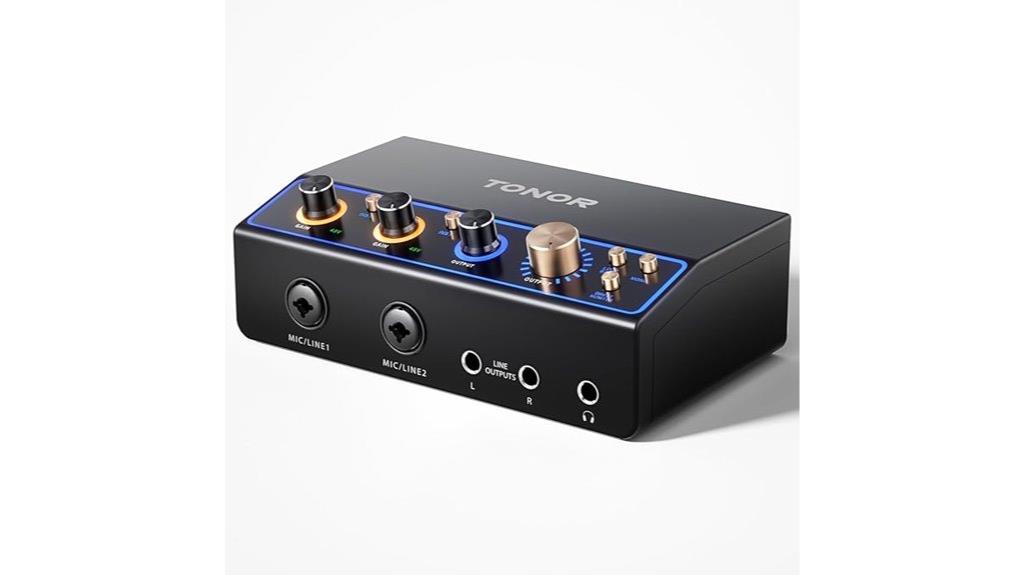
Designed with beginners in mind, the TONOR 202 Audio Interface offers an intuitive setup and versatile features that make recording and streaming straightforward. It supports professional-quality sound with high fidelity, ensuring clear, accurate audio for podcasts, streaming, or music. With 2 XLR and 6.35mm combo inputs, I can connect two sources simultaneously, and the INST button quickly switches between instrument and vocal modes. Its stylish design features vibrant breathing lights and easy-to-use controls, including volume knobs and indicator lights. Compact and portable, the TX510 is compatible with Windows and macOS, making it a reliable choice for content creators seeking affordability and performance.
Best For: beginners and content creators seeking an easy-to-use, versatile audio interface for recording, streaming, podcasting, and music production on a budget.
Pros:
- User-friendly setup with intuitive controls ideal for beginners
- Supports two audio sources simultaneously with versatile input options
- Stylish design with vibrant lighting effects enhances workspace aesthetics
Cons:
- Limited advanced features for professional audio engineers
- Slightly heavier than some compact interfaces, which may affect portability for some users
- May require additional accessories or software for optimal use in complex setups
USB Audio Interface for PC and Mac, 24-bit/192kHz Recording and Streaming

A USB audio interface with 24-bit/192kHz recording and streaming offers professional-level sound quality in an easy-to-use package, making it ideal for beginners. It features 2 inputs and 2 outputs, including combo jacks for microphones and instruments, plus balanced outputs for speakers. The interface supports phantom power for condenser mics and provides zero-latency monitoring through a headphone jack. Compatibility with popular recording software on both PC and Mac means setup is straightforward, often no driver installation needed. Its compact, durable design makes it perfect for home studios, streaming, or mobile use, delivering high-quality sound without complexity.
Best For: beginners and home studio enthusiasts seeking affordable, easy-to-use audio recording and streaming solutions on PC or Mac.
Pros:
- Provides professional 24-bit/192kHz sound quality with clear, detailed audio.
- Plug-and-play setup with compatibility across major recording software and no driver installation on supported systems.
- Compact, durable aluminum design ideal for mobile use and small spaces.
Cons:
- Gain controls can be sensitive, making precise adjustments challenging.
- Some users report reliability issues and device failure over time.
- Limited adjustment range and occasional popping noises may affect some recordings.
XTUGA USB Audio Interface for PC and Recording Studio
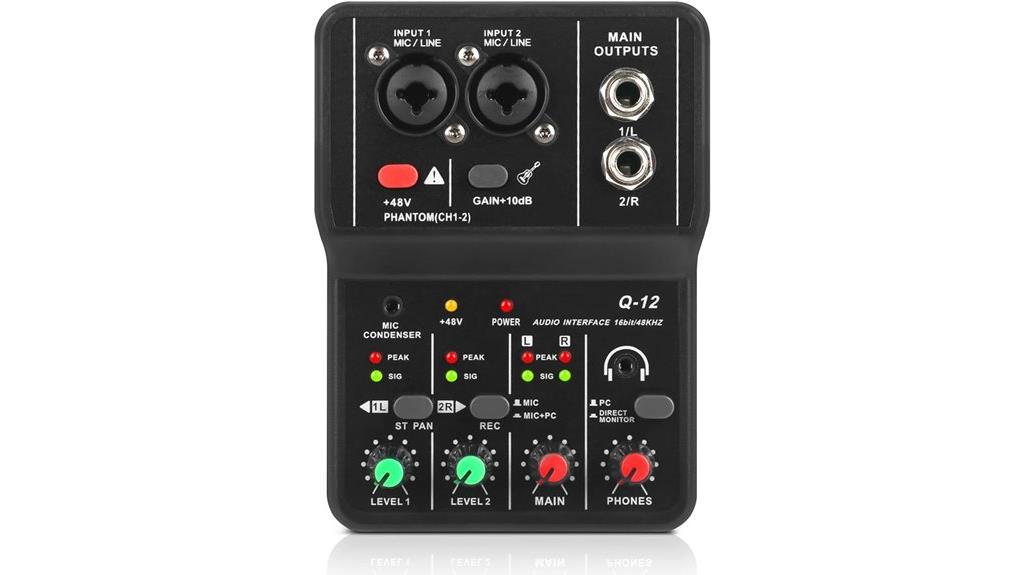
The XTUGA USB Audio Interface (Model Q-12) stands out as an ideal choice for beginners who want a straightforward, reliable device to enhance their recording setup. Its compact, lightweight design makes it portable and easy to transport, perfect for both studio and on-the-go use. The plug-and-play setup works seamlessly with Windows and Mac, with no drivers needed. It features two inputs—XLR with phantom power and a 3.5mm jack—making it versatile for microphones and instruments. With 16-bit/48kHz resolution, independent volume controls, and clear indicators, it delivers professional-quality sound at an affordable price, ideal for new users.
Best For: beginners and budget-conscious users seeking a portable, easy-to-use audio interface for home recordings, podcasts, and small studio setups.
Pros:
- Compact and lightweight design for portability and easy handling
- Plug-and-play operation compatible with Windows and Mac without drivers
- Delivers professional-quality sound at an affordable price with clear indicators and independent controls
Cons:
- Limited to two inputs, which may restrict more complex recording setups
- Mono channels output as single mono rather than true stereo in some configurations
- Short USB cable may require an extension for convenient placement
MAONO Gaming Audio Mixer with Bluetooth and Phantom Power
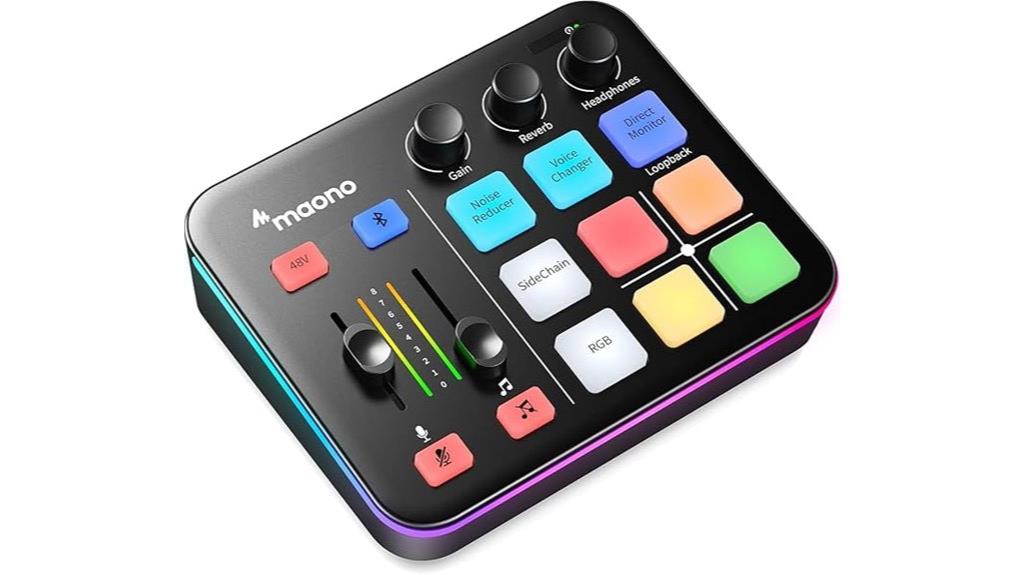
If you’re just starting out with streaming or gaming, the MAONOCASTER G1 NEO is a great choice because it simplifies high-quality audio setup. It works with phones, computers, tablets, PS4, and PS5, supporting popular platforms like OBS, Twitch, YouTube, and Zoom. Its compact design and user-friendly controls make setup straightforward. Equipped with a pro-preamp and 48V phantom power, it releases the full potential of XLR microphones for clear, professional sound. Plus, features like voice effects, noise reduction, and RGB lighting let you customize your streams easily. It’s an affordable, versatile mixer perfect for beginners looking to upgrade their audio game.
Best For: beginners and intermediate gamers, streamers, and content creators seeking an easy-to-use, versatile audio mixer with high-quality sound and customization options.
Pros:
- Supports a wide range of devices including phones, computers, tablets, PS4, and PS5, enhancing flexibility.
- Equipped with professional features like 48V phantom power and voice effects for high-quality, customizable audio.
- Compact design with user-friendly controls and RGB lighting for an immersive streaming environment.
Cons:
- Not compatible with USB microphones, Xbox, or MAONO devices, limiting some device options.
- Lacks integrated USB microphone support, which may require additional equipment for certain users.
- May have limited advanced audio processing features compared to higher-end professional mixers.
PUPGSIS Gaming Audio Mixer with 4 Channels and Voice Effects

For beginners looking to enhance their streaming, gaming, or podcasting setup, the PUPGSIS Gaming Audio Mixer stands out with its intuitive interface and versatile features. Its compact, stylish design includes color-coded knobs, RGB lighting, and multiple connectivity options like Bluetooth 5.3, 3.5mm, and XLR inputs, making it easy to set up and use. The mixer delivers high-quality audio with a professional preamp and phantom power, supporting multiple microphones and devices. With six voice-changing modes, soundpads, reverb presets, and independent volume controls, it offers creative flexibility. Overall, it’s a user-friendly, reliable choice perfect for those starting in content creation.
Best For: beginners and intermediate content creators seeking an easy-to-use, versatile audio mixer for streaming, gaming, and podcasting.
Pros:
- User-friendly interface with color-coded controls and RGB lighting for easy operation
- Supports multiple microphones and devices, including Bluetooth, XLR, and 3.5mm inputs
- Offers creative features like voice-changing modes, soundpads, and reverb presets for enhanced content
Cons:
- Occasional faint buzz during silence may be noticeable in quiet recordings
- Some ports are 1/8-inch rather than XLR or 1/4-inch, limiting professional connectivity options
- Minor connectivity issues reported with certain devices, such as Xbox or specific cables
Factors to Consider When Choosing USB Audio Interfaces for Beginners

When choosing a USB audio interface, I focus on how well it works with my devices and the types of inputs and outputs it offers. Sound quality standards and software compatibility are also key to making sure I get professional results. Ultimately, I consider how easy it is to set up and connect everything for a smooth recording experience.
Compatibility With Devices
Choosing a USB audio interface that works smoothly with your devices is vital for a hassle-free recording experience. First, make sure it’s compatible with your operating system, whether Windows, macOS, iOS, or Android, so everything connects seamlessly. Check if it supports plug-and-play, which means you can set it up easily without installing extra drivers or software. Also, confirm the USB port type—USB-A, USB-C, or USB 3.0—matches your computer or mobile device for stable data transfer. Compatibility with your preferred recording or streaming software, like DAWs or broadcasting platforms, is essential for smooth operation. Finally, verify it can connect with your existing hardware, such as microphones, instruments, or headphones, through supported input and output standards.
Input and Output Options
Selecting a USB audio interface involves more than just compatibility; it’s also about ensuring it has the right input and output options for your setup. I look for interfaces with essential input types like XLR for mics and 1/4-inch or 3.5mm jacks for instruments or line-level devices. Multiple outputs, such as headphone, stereo, or monitor, provide flexible monitoring options. It’s important to verify the number of inputs and outputs to match your recording needs, whether you’re working solo or multi-source projects. Independent volume controls for each input and output are a big plus, allowing precise adjustments during recording and playback. Also, I check for features like phantom power (+48V) if I plan to use condenser microphones needing external power.
Sound Quality Standards
Sound quality is the backbone of any good recording, and for beginners, understanding what factors influence it can make a big difference. Key elements include bit depth and sample rate; 24-bit/96kHz or higher ensures clear, professional sound. High-quality interfaces feature low Total Harmonic Distortion (THD) and ultra-low noise preamps, which preserve clarity without hiss. The converters—both analog-to-digital and digital-to-analog—play an essential role in maintaining audio fidelity, offering accurate, detailed sound with minimal signal loss. A consistent frequency response across the spectrum guarantees natural, balanced playback. Proper shielding and grounding within the device help prevent electromagnetic interference, guaranteeing recordings stay clean and free of unwanted noise. Prioritizing these standards helps you achieve high-quality recordings right from the start.
Ease of Setup
Since ease of setup is essential for beginners, it’s important to look for USB audio interfaces that are simple to connect and operate. Plug-and-play models that require no driver installation are ideal, as they let you get started quickly without technical hassle. Devices with clear, labeled controls and minimal buttons help you understand and adjust settings easily. Compact and lightweight designs make connecting, positioning, and transporting the interface straightforward. Many interfaces support multiple operating systems, such as Windows, macOS, iOS, and Android, with simple connection procedures. Features like auto-detection and integrated preamps can further streamline initial setup, ensuring you spend less time troubleshooting and more time recording. An easy setup process makes your recording experience smooth and enjoyable from the start.
Software Compatibility
When choosing a USB audio interface, ensuring it’s compatible with your preferred digital audio workstation (DAW) and operating system is essential. I recommend checking if the interface supports major DAWs like Ableton Live, Pro Tools, Logic Pro, or FL Studio, so your workflow remains smooth. Compatibility with your operating system—whether Windows, macOS, iOS, or Android—is equally important to prevent driver or software issues down the line. Look for plug-and-play models or those with driverless operation to make setup easier. Also, verify if the included software bundle offers compatible recording or editing tools, which can save you money. Ultimately, consider whether the manufacturer provides regular driver updates and support to keep your interface working seamlessly as your recording needs grow.
Build Durability
Choosing a USB audio interface that’s built to last is essential, especially if you plan to use it regularly or take it on the go. A durable design often features a sturdy metal or high-quality plastic chassis that can withstand daily use and transport. Reinforced connectors and cables help prevent wear and tear, ensuring reliable connections over time. Inside, shock-absorbing components minimize damage from accidental drops or impacts, which is vital for a mobile setup. Well-designed internal circuitry with effective heat dissipation reduces the risk of overheating and component failure, extending the device’s lifespan. Overall, a sturdy build means your interface will stay reliable through frequent use, making it a smart choice whether you’re setting up a home studio or recording on the move.
Budget Considerations
Budget is a key factor to contemplate when selecting a USB audio interface for beginners. These interfaces usually range from $50 to $150, so affordability is essential. Lower-priced models often have limited inputs, lower resolution (16-bit/48kHz), or fewer features, which can affect recording quality. On the other hand, more expensive options typically offer higher bit-depths (24-bit), higher sample rates (192kHz), and better preamps, but they might be outside a beginner’s budget. Budget-friendly models prioritize portability and simplicity, making them perfect for newcomers with basic needs. It’s important to find a balance—choose an interface that fits your current needs without sacrificing too much quality or future upgrade potential. That way, you won’t need to replace it too soon.
Latency and Monitoring
Latency and monitoring are critical factors to contemplate because they directly impact your recording experience. Low latency, ideally under 10 milliseconds, ensures real-time monitoring without distracting delays. Zero-latency direct monitoring allows you to hear your input signals instantly, improving performance and accuracy. Many interfaces let you adjust the monitoring mix independently from playback, helping you balance your live input with existing tracks. Higher-quality interfaces often feature dedicated hardware controls for monitoring, reducing latency and processing lag. Properly configured drivers and buffer sizes are essential to keep latency minimal and ensure reliable monitoring throughout your recording sessions. Choosing an interface with these features makes the recording process smoother, more intuitive, and ultimately more enjoyable, especially for beginners who want a hassle-free experience.
Frequently Asked Questions
How Do I Connect a Microphone or Instrument to a USB Audio Interface?
Connecting a microphone or instrument to a USB audio interface is simple. I plug my microphone or instrument into the appropriate input, usually XLR for mics and 1/4-inch for instruments. Then, I connect the interface to my computer via USB. I make sure the drivers are installed if needed, and set the interface as my audio device in my recording software. That’s it—ready to record!
What Is the Difference Between 24-Bit and 16-Bit Recording Quality?
The main difference between 24-bit and 16-bit recording quality is the dynamic range and detail. 24-bit provides a higher dynamic range, allowing for more nuanced recordings with less noise and better headroom. I recommend 24-bit for professional-sounding recordings, as it captures more detail. 16-bit is sufficient for basic projects and everyday use, but if you want higher quality, go for 24-bit.
Can I Use These Interfaces With Both Windows and Mac Computers?
Think of these interfaces as universal keys—they open doors to both Windows and Mac worlds. Yes, most of these beginner-friendly USB audio interfaces are compatible with both systems. I’ve found that manufacturers design them to be versatile, so you won’t need to worry about locking yourself out. Just check the specs to confirm compatibility, and you’re good to go, whether you’re on a Windows PC or a Mac.
Do Beginner USB Audio Interfaces Support Live Streaming Directly?
Yes, many beginner USB audio interfaces support live streaming directly. I’ve used some that work seamlessly with platforms like Twitch or OBS, allowing me to connect my mic and headphones easily. They often come with plug-and-play setup, so you don’t need extra gear or complex configurations. Just make certain the interface is compatible with your computer, and you’re good to go. It makes live streaming straightforward and professional-looking.
Is Phantom Power Necessary for Condenser Microphones?
Absolutely, phantom power is essential for condenser microphones. Without it, your mic won’t even turn on, let alone produce clear sound. These mics need external power to operate their internal capsules, which captures detailed, studio-quality audio. So, if you’re planning to use a condenser mic, make certain your audio interface supplies phantom power—trust me, it’s the secret ingredient to professional-sounding recordings.
Conclusion
Choosing the right USB audio interface feels like balancing between simplicity and power. While some models offer beginner-friendly features, others pack professional-grade options that can grow with you. It’s tempting to go for the cheapest, but investing in the right device now can save you headaches later. Remember, your ideal interface isn’t just about affordability—it’s about finding that perfect blend of ease and quality to jumpstart your recording journey confidently.



